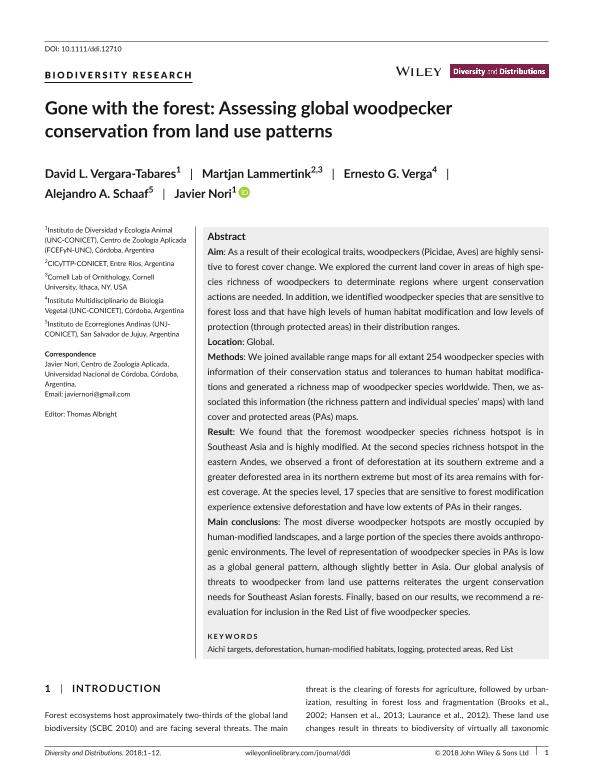Mostrar el registro sencillo del ítem
dc.contributor.author
Vergara Tabares, David Lautaro

dc.contributor.author
Lammertink, J. Martjan

dc.contributor.author
Verga, Ernesto Gustavo

dc.contributor.author
Schaaf, Alejandro Alberto

dc.contributor.author
Nori, Javier

dc.date.available
2019-07-24T18:19:09Z
dc.date.issued
2018-05
dc.identifier.citation
Vergara Tabares, David Lautaro; Lammertink, J. Martjan; Verga, Ernesto Gustavo; Schaaf, Alejandro Alberto; Nori, Javier; Gone with the forest: Assessing global woodpecker conservation from land use patterns; Wiley Blackwell Publishing, Inc; Diversity and Distributions; 24; 5; 5-2018; 640-651
dc.identifier.issn
1366-9516
dc.identifier.uri
http://hdl.handle.net/11336/80168
dc.description.abstract
As a result of their ecological traits, woodpeckers (Picidae, Aves) are highly sensitive to forest cover change. We explored the current land cover in areas of high species richness of woodpeckers to determinate regions where urgent conservation actions are needed. In addition, we identified woodpecker species that are sensitive to forest loss and that have high levels of human habitat modification and low levels of protection (through protected areas) in their distribution ranges. Location: Global. Methods: We joined available range maps for all extant 254 woodpecker species with information of their conservation status and tolerances to human habitat modifications and generated a richness map of woodpecker species worldwide. Then, we associated this information (the richness pattern and individual species’ maps) with land cover and protected areas (PAs) maps. We found that the foremost woodpecker species richness hotspot is in Southeast Asia and is highly modified. At the second species richness hotspot in the eastern Andes, we observed a front of deforestation at its southern extreme and a greater deforested area in its northern extreme but most of its area remains with forest coverage. At the species level, 17 species that are sensitive to forest modification experience extensive deforestation and have low extents of PAs in their ranges.The most diverse woodpecker hotspots are mostly occupied by human-modified landscapes, and a large portion of the species there avoids anthropogenic environments. The level of representation of woodpecker species in PAs is low as a global general pattern, although slightly better in Asia. Our global analysis of threats to woodpecker from land use patterns reiterates the urgent conservation needs for Southeast Asian forests. Finally, based on our results, we recommend a re-evaluation for inclusion in the Red List of five woodpecker species.
dc.format
application/pdf
dc.language.iso
eng
dc.publisher
Wiley Blackwell Publishing, Inc

dc.rights
info:eu-repo/semantics/openAccess
dc.rights.uri
https://creativecommons.org/licenses/by-nc-sa/2.5/ar/
dc.subject
Aichi Targets
dc.subject
Deforestation
dc.subject
Human-Modified Habitats
dc.subject
Logging
dc.subject
Protected Areas
dc.subject
Red List
dc.subject.classification
Conservación de la Biodiversidad

dc.subject.classification
Ciencias Biológicas

dc.subject.classification
CIENCIAS NATURALES Y EXACTAS

dc.title
Gone with the forest: Assessing global woodpecker conservation from land use patterns
dc.type
info:eu-repo/semantics/article
dc.type
info:ar-repo/semantics/artículo
dc.type
info:eu-repo/semantics/publishedVersion
dc.date.updated
2019-07-24T15:35:07Z
dc.identifier.eissn
1472-4642
dc.journal.volume
24
dc.journal.number
5
dc.journal.pagination
640-651
dc.journal.pais
Reino Unido

dc.journal.ciudad
Londres
dc.description.fil
Fil: Vergara Tabares, David Lautaro. Consejo Nacional de Investigaciones Científicas y Técnicas. Centro Científico Tecnológico Conicet - Córdoba. Instituto de Diversidad y Ecología Animal. Universidad Nacional de Córdoba. Facultad de Ciencias Exactas Físicas y Naturales. Instituto de Diversidad y Ecología Animal; Argentina
dc.description.fil
Fil: Lammertink, J. Martjan. Cornell University; Estados Unidos. Provincia de Entre Ríos. Centro de Investigaciones Científicas y Transferencia de Tecnología a la Producción. Universidad Autónoma de Entre Ríos. Centro de Investigaciones Científicas y Transferencia de Tecnología a la Producción. Consejo Nacional de Investigaciones Científicas y Técnicas. Centro Científico Tecnológico Conicet - Santa Fe. Centro de Investigaciones Científicas y Transferencia de Tecnología a la Producción; Argentina
dc.description.fil
Fil: Verga, Ernesto Gustavo. Consejo Nacional de Investigaciones Científicas y Técnicas. Centro Científico Tecnológico Conicet - Córdoba. Instituto Multidisciplinario de Biología Vegetal. Universidad Nacional de Córdoba. Facultad de Ciencias Exactas Físicas y Naturales. Instituto Multidisciplinario de Biología Vegetal; Argentina
dc.description.fil
Fil: Schaaf, Alejandro Alberto. Consejo Nacional de Investigaciones Científicas y Técnicas. Centro de Investigaciones y Transferencia de Jujuy. Universidad Nacional de Jujuy. Centro de Investigaciones y Transferencia de Jujuy; Argentina
dc.description.fil
Fil: Nori, Javier. Consejo Nacional de Investigaciones Científicas y Técnicas. Centro Científico Tecnológico Conicet - Córdoba. Instituto de Diversidad y Ecología Animal. Universidad Nacional de Córdoba. Facultad de Ciencias Exactas Físicas y Naturales. Instituto de Diversidad y Ecología Animal; Argentina
dc.journal.title
Diversity and Distributions

dc.relation.alternativeid
info:eu-repo/semantics/altIdentifier/doi/https://doi.org/10.1111/ddi.12710
dc.relation.alternativeid
info:eu-repo/semantics/altIdentifier/url/https://onlinelibrary.wiley.com/doi/full/10.1111/ddi.12710
Archivos asociados
